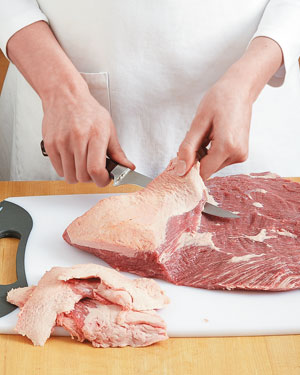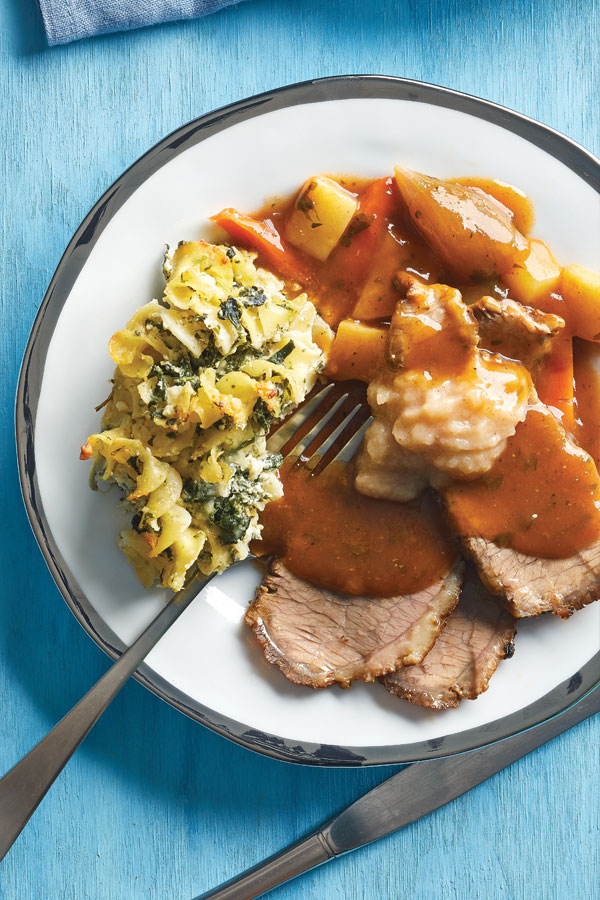Braising Brisket
How do you cook a tough, flat piece of meat? With less-than-tender cuts like brisket, the moist, gentle heat of braising is the answer.

(Note: This post contains affiliate links. As an Amazon Associate, we earn from qualifying purchases made through affiliate links.)
How do you cook a tough, flat piece of meat? With less-than-tender cuts like brisket, the moist, gentle heat of braising is the answer. It melts intramuscular fat (fat you can’t see) and breaks down tough connective tissues. Braising isn’t a quick cooking method and takes some time. But your patience will pay off in a big way with a potful of tender, rich, flavorful beef.
What is brisket?
To be blunt, brisket is tough. It’s a chest muscle close to the front legs of a steer. Full of well worked muscle and connective tissue, brisket lacks tenderness, but makes truly beefy flavored meat.
What you’re probably going to find in most grocery stores is the “flat” cut of brisket. It looks pretty lean except for a thin layer of fat on the outside. Don’t confuse it with corned beef brisket, which is cured like ham and bright red. You want fresh beef, as with a steak or roast.
 Trim the surface fat by sliding a
sharp knife underneath the silverskin, making a “tab.” Hold the tab
and slice off the fat and silverskin.
Trim the surface fat by sliding a
sharp knife underneath the silverskin, making a “tab.” Hold the tab
and slice off the fat and silverskin.
What is braising?
Braising is actually a combination of cooking methods that includes three steps:
- Browning
- Deglazing
- Simmering
Even with a number of steps, it’s one of the easier techniques to use. Active cooking (searing and deglazing) is done at the beginning, then once it’s in the oven simmering, you might almost forget about it (except for the great aroma), so set a timer.
Step 1: Browning
The flavor and color foundation for this technique lies in browning. Keep these things in mind here. First, the browner the meat, the better. To brown well, use a large, heavy Dutch oven or stock pot. It will distribute heat evenly and will be less likely to have hot spots that scorch.
Second, be sure the meat is blotted dry. A moist surface creates steam, and that prevents good browning.
Finally, use medium-high heat to sear, and don’t be afraid to use a fair amount of oil to prevent burning. The rendered bacon fat here builds in a smoky flavor.
Step 2: Deglazing
Browning the bacon and beef creates a caramelized layer of sugars and proteins stuck on the bottom of the pan. To loosen it, the pan has to be “deglazed.” Liquids are usually used for this, but a mirepoix — vegetable mixture — can also be used. Scrape the pot well here; as that stuck-on layer is loosened and dissolves, it establishes the deep color and flavor for the sauce.
After deglazing, most of your work is done. The oven finishes the job.
Step 3: Simmering
Besides the meat, the one essential ingredient in a braise is the liquid. As it simmers, it lets off steam which melts fat and breaks down tough fibers and muscle tissue. Be sure the pot is covered with a tight-fitting lid. This builds up the penetrating steam heat and keeps it in the pot, not escaping through gaps. It also helps capture the juices from the meat, concentrating them into the sauce.
Finishing
To finish, transfer brisket to a cutting board, tent with foil, and let rest 5–10 minutes. Meanwhile, strain the broth and return it to a clean pan. Its flavor is pretty one-dimensional at this point, but additions like vinegar and herbs help to punch it up, while cornstarch helps to thicken it.
Slice the brisket, and serve it with a side or two — now that is a meal worth waiting for! Aren’t you glad you stayed home for dinner?

Get the Recipe
Now that you know how to braise, grab our recipe for Oven-Braised Beef Brisket with celery root & carrots and get cooking!
Product Recommendations
Interested in cooking? Need some supplies?
Check out some of the tools we like. All products featured on Cuisine at Home are independently selected by our editors; we may earn an affiliate commission from qualifying purchases through our links.